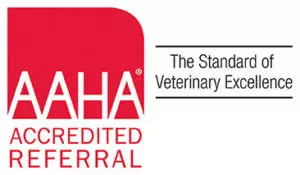Radioiodine Therapy (I-131)
If your cat is exhibiting signs of hyperthyroidism, it’s important to know that Long Island Veterinary Specialists offers a safe and effective treatment to help restore his or her good health. It’s called radioiodine or I-131, and it’s considered the best option to cure hyperthyroidism today.
A safe, effective and curative option
What is hyperthyroidism?
Hyperthyroidism is a condition that affects some older cats when certain cells in the thyroid gland begin to produce excessive amounts of thyroid hormones. This throws the cat’s metabolic rate into overdrive, causing symptoms such as weight loss, increased appetite, restlessness, increased water consumption, a fast heart rate, vomiting, and diarrhea.
With minimally invasive procedures, pets experience less discomfort, shorter hospital stays, and have faster recovery times. Interventional radiology is often more cost-effective than surgery, involves less risk than traditional surgical intervention, and allows us to treat many diseases in small animals that were previously difficult to treat.
How is radioiodine used?
Radioiodine (I-131) is a minimally invasive alternative to thyroid gland surgery or daily medication. Over 95% of cats will be cured of hyperthyroidism with a single injection.
Iodine is used naturally by the thyroid gland, but by no other gland or organ in the body. As a result, when radioactive iodine is injected into the body, it goes right to the thyroid gland where it’s absorbed by the hyperactive thyroid cells, killing them.
The radioiodine doesn’t travel elsewhere in the body and nearby structures are not affected. Any radioactive iodine not collected by the thyroid gland will be naturally eliminated within a few days through urine and feces.
Cats admitted for radioiodine therapy will spend 3 to 5 days at LIVS in comfortable accommodations until the radioactive iodine has been excreted from their system and it’s safe for them to return home.
Advantages of Radioiodine (I-131)
- Daily pilling is eliminated
- This one-time procedure is more cost-effective than surgery or daily medication
- No anesthesia required
- Normal thyroid tissue is not affected
- It destroys thyroid tumors
- Thyroid function returns to normal within a few weeks
Disadvantages of radioiodine therapy
The major disadvantage associated with radioiodine therapy is that your cat must be quarantined in the hospital for 3 to 5 days after treatment, with visitation not permitted until the level of radioactivity decreases to a safe level.
Is my cat a good candidate for radioiodine therapy?
The major disadvantage associated with radioiodine therapy is that your cat should be free of significant cardiovascular (heart), renal (kidney), gastrointestinal or endocrine disease, and not aggressive in nature. Most patients presenting for evaluation are middle- to older-aged cats, often suffering from other health conditions, so we conduct a comprehensive assessment before recommending this treatment. If you would like to know more about radioiodine therapy for your cat, please ask your primary care veterinarian about a referral to LIVS for a consultation.
Radioiodine Team

Dominic J. Marino, DVM
Dip. ACVS, Dip. ACCT, CCRP
Soft Tissue, Oncologic, Orthopedic, Neurosurgery, Physical Rehabilitation

Joshua W. Tumulty, DVM
Dip. ACVIM (Internal Medicine)
Internal Medicine,
Radioiodine Therapy (I-131)


